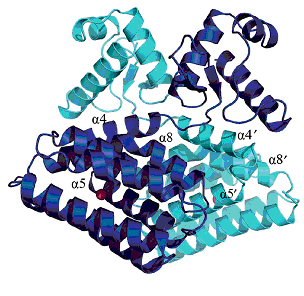

ABSTRACT
LldR (CGL2915) from Corynebacterium glutamicum is a transcription factor belonging to the GntR family, which is typically involved in the regulation of oxidized substrates associated with amino acid metabolism. In the present study, the crystal structure of LldR was determined at 2.05-A resolution. The structure consists of N- and C-domains similar to those of FadR, but with distinct domain orientations. LldR and FadR dimers achieve similar structures by domain swapping, which was first observed in dimeric assembly of transcription factors. A structural feature of Zn2+ binding in the regulatory domain was also observed, as a difference from the FadR subfamily. DNA microarray and DNase I footprint analyses suggested that LldR acts as a repressor regulating cgl2917-lldD and cgl1934-fruK-ptsF operons, which are indispensable for L-lactate and fructose/sucrose utilization, respectively. Furthermore, the stoichiometries and affinities of LldR and DNAs were determined by isothermal titration calorimetry measurements. The transcriptional start site and repression of LldR on the cgl2917-lldD operon were analysed by primer extension assay. Mutation experiments showed that residues Lys4, Arg32, Arg42 and Gly63 are crucial for DNA binding. The location of the putative ligand binding cavity and the regulatory mechanism of LldR on its affinity for DNA were proposed.
FIGURE CAPTION
Ribbon representation of the LldR-Zn2+ dimer. The two monomers are coloured cyan and blue.
REFERENCES
Structural and functional characterization of the LldR from Corynebacterium glutamicum: a transcriptional repressor involved in L-lactate and sugar utilization.
Yong-Gui Gao, Hiroaki Suzuki, Hiroshi Itou, Yong Zhou, Yoshikazu Tanaka, Masaaki Wachi, Nobuhisa Watanabe, Isao Tanaka, and Min Yao.
Nucl. Acid Res. 36, 7110-7123 (2008)